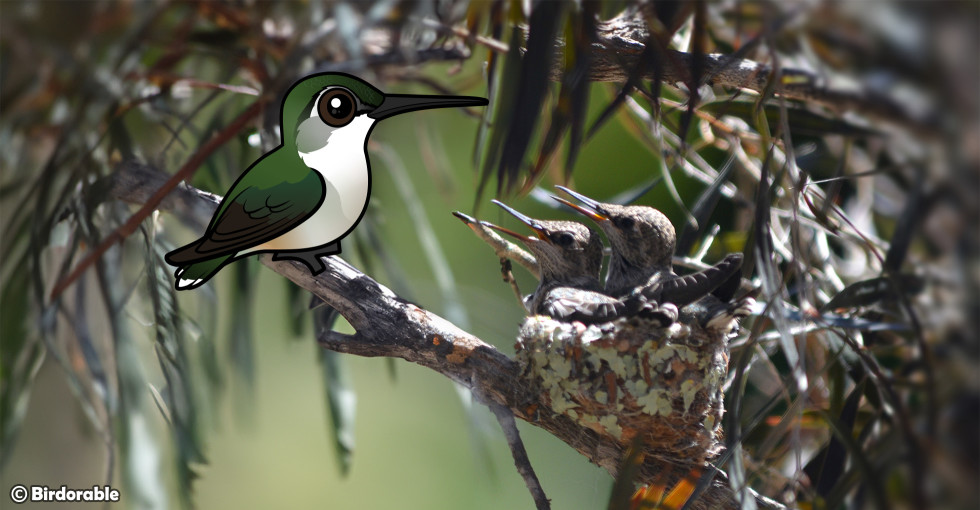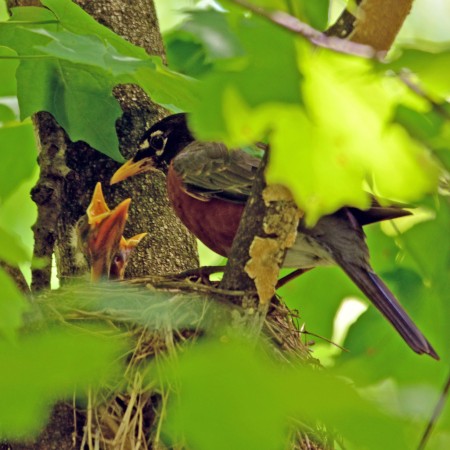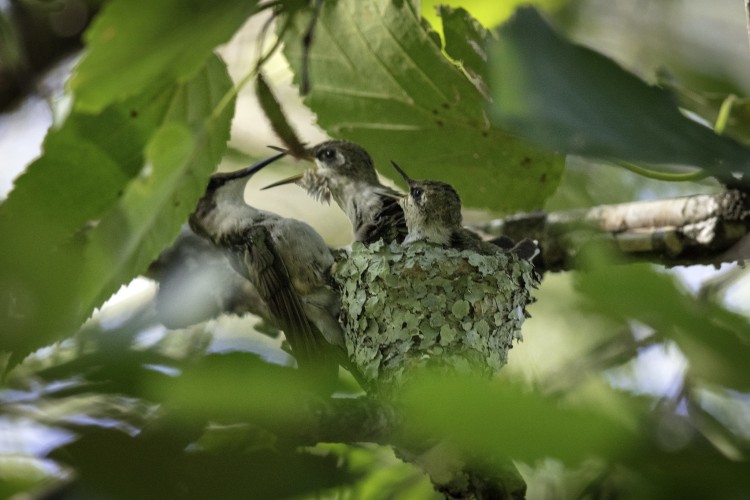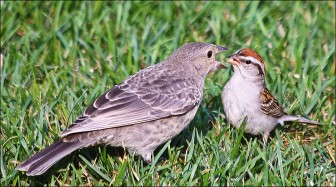Beyond Two Parents: Unraveling Bird Rearing Techniques

Ruby-throated Hummingbird with nest
When it comes to raising their young, birds exhibit a fascinating array of parenting strategies.
One common myth about bird parenting is that it always requires two parents — one male and one female — to successfully raise their young. While this is true for many bird species, it's not a universal rule. The parenting styles in the avian world are as varied and complex as the birds themselves. The truth is much more nuanced and interesting. Let's explore the myth that two parents are required to raise baby birds.

American Robin Tending Young by Courtney Celley/USFWS (Public Domain)
Paired Chick-Rearing Is Typical
In many bird species, parenting is indeed a dual activity. Take, for example, the familiar American Robin. While the female takes care of incubating the eggs, both are involved in feeding and protecting the fledglings. This shared responsibility ensures that at least one parent is always guarding and nurturing the offspring, increasing their survival chances in the unpredictable wild.
Similarly, some species of penguins are famed for their cooperative parenting. In the strategy of the Emperor Penguin, the male takes the first long shift standing over the eggs through the harshest winter conditions, without eating, while the female goes to sea to feed. Upon her return, roles switch, with the female taking over chick-rearing duties. This level of mutual participation is crucial for survival in their extreme environment.
Sometimes Single Parenting Is the Norm
Despite the prevalence of this model, several bird species challenge the notion that two parents are strictly necessary. In some species, single-parent families are not only common but are the norm. For instance, in the case of the Ruby-throated Hummingbird, females manage the bulk of parenting duties on their own, from brooding to feeding and protection.
In the case of the African Jacana, the female is the dominant and more territorial individual. She mates with multiple males, and it’s these males who incubate the eggs and take care of the chicks solo. This role reversal shows how diverse bird parenting can be.

Female Ruby-throated Hummingbird feeds nestlings by Lorie Shaull (CC BY 2.0 Deed)
Some Species Practice Breeding Cooperation
The variability in bird parenting strategies extends even further with communal breeding, where multiple birds share parenting duties, sometimes involving individuals that are not the biological parents of or even biologically related to the young. Species like the Acorn Woodpecker live in large family groups where several females lay eggs in the same nest and the group collectively takes care of all the young. This communal approach can alleviate the burden on any single bird and enhance the survival rates of the nestlings.
In some species of birds, such as the Florida Scrub-Jay, older siblings from previous broods help in feeding and protecting the new chicks of subsequent broods. This behavior not only supports the current breeding pair but also provides valuable parenting experience to the younger birds.

Chipping Sparrow feeding baby cowbird by Sue Thompson (CC BY-ND 2.0 Deed)
Zero Parenting: Brood Parasitism
Then there are brood parasites like the Brown-headed Cowbird, who lay their eggs in the nests of other bird species. The cowbird chick, once hatched, often pushes out the host's eggs and becomes the sole beneficiary of the unsuspecting foster parents' care. This strategy completely removes the biological parents from the nurturing equation, relying instead on deception for the survival of the offspring.
The reasons behind these varied parenting strategies are complex and influenced by ecological and evolutionary pressures. Factors such as predator density, food availability, and environmental conditions can dictate whether a species evolves to favor single parenting, bi-parental care, or communal breeding.
The Loss of an Adult In Paired Chick-Rearing
In species where two parents are generally involved in raising the chicks, the presence of both ensures optimal care: one can forage for food while the other protects and warms the young. However, should one parent perish, the remaining parent may face increased challenges but not necessarily insurmountable ones. The success of single-parenting in such cases largely depends on factors like the species’ natural behavior, the stage of the nestling period, and the environmental conditions.
For instance, in many songbirds, if the male dies after the chicks have hatched, the female alone might still manage to raise the chicks to fledging. This is possible because the most labor-intensive period requiring both parents, which includes egg incubation and early chick rearing, may have passed. At this stage, the demand is primarily for feeding the rapidly growing chicks. If food is abundant and the threats from predators are minimal, a single mother could potentially manage the workload alone.
In the case of the death of the female, leaving the male to care for the eggs or very young chicks, the scenario might be different. In many bird species, males might not be physiologically equipped to incubate eggs or might not have the behavior programmed for such tasks.
As demonstrated in the examples above, environmental factors play a significant role in nest survival when one parent is lost. In a habitat where food is plentiful and easily accessible, the surviving parent has a better chance of successfully feeding the chicks and themselves. However, in a scenario where food is scarce or requires significant effort to obtain, the stress and physical demands on the single parent could lead to lower success rates for the nest. And the timing of the parent’s death certainly affects outcomes.
Some bird species have also shown the capacity to find new mates quickly if their partner dies, thereby restoring the dual care system. This flexibility can greatly enhance the survival prospects of the current brood.
Dual Parenting In Birds Myth: Busted
The myth that all birds require two parents to successfully raise their young does not hold up under scrutiny. The avian world is rich with diverse parenting strategies, each adapted to the specific needs and challenges of different species. This diversity demonstrates the adaptability and complexity of birds, making them endlessly fascinating subjects of study and observation.





Comments
Leave a comment
Thank you!